Chapter 12. Social Interaction
| Books - On Being Stoned |
Drug Abuse
Chapter 12. Social Interaction
MUCH MARIJUANA use is carried out in the company of other users. This results not only in a variety of effects on interpersonal relations, but the gestalt configuration of a group of users at any given time can strongly affect each user's individual experiences.
We shall consider social effects under three semi-distinct categories: (1) overall characteristics of groups of intoxicated users; (2) perceptions of the quality of social interaction; and (3) some negative effects on social interaction.
OVERALL CHARACTERISTICS OF INTOXICATED GROUPS
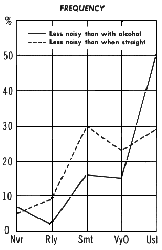 |
| Figure 12-1. NOISINESS AT PARTIES |
Quieting Effects
An extremely characteristic effect of marijuana intoxication, in comparison to alcohol intoxication, is "I am less noisy and boisterous at parties than when drunk or tipsy on alcohol" (7%, 2%, 16%, 15%, 51%). One informant remarked, "When the cops walk into a party and everybody is yelling, arguing, and reeling around, they don't bother you; but if everybody is sitting around quietly talking or listening to music, they hassle you because they're pretty sure you're stoned!" Moderate Total use is associated with a higher frequency of this than Light, and Light with a higher frequency than Heavy (p <.05, overall). Quietness begins to occur at Low levels of intoxication (23%, 27%, 20%, 9%, 1%).
This sort of quietness is characteristic even without a comparison with alcohol intoxication: "I am less noisy and boisterous at parties than when straight" (5%, 9%, 30%, 23%, 29%). This is reported less frequently by the Occasional users (p <.05, overall). Users of Psychedelics do not need to be as intoxicated to experience this (p <.05), and the effect generally begins at Moderate levels (16%, 30%, 29%, 11%, 3%).
Being less noisy than when intoxicated on alcohol is more frequent (p <.0005) than being quieter than when straight, as shown in Figure 12-1, but they occur at essentially the same levels of intoxication.
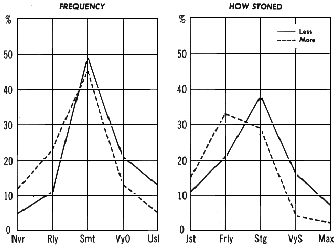 |
| Figure 12-2. AMOUNT OF TALKING WHEN INTOXICATED Note.—For guide to interpreting the "How Stoned" graph, see note on Figure 6-1. |
This general quieting effect of marijuana intoxication in social groups generally is further reflected in the very common effect, "I talk a lot less than when straight" (5%, 11%, 49%, 21%, 13%), an effect that begins to occur in the Moderate to Strong ranges of intoxication (11%, 21%, 38%, 16%, 7%). The converse effect, "I talk a lot more than when straight" is a common effect (12%, 23%, 45%, 13%, 5%), which begins in the Moderate levels of intoxication (15%, 33%, 29%, 4%, 2%), but it occurs significantly less frequently (p <.01) and at lower levels of intoxication (p <.0005) than talking less, as shown in Figure 12-2.
The Meditators less often report that they talk more when intoxicated (p <.05, overall). The College-educated need to be more intoxicated to talk more (p <.05), as do Users of Psychedelics (p <.01).
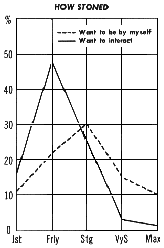 |
| Figure 12-3. SOCIABILITY |
Sociability
"I become more sociable: I want to be with and interact with people more" is a common effect (5%, 17%, 45%, 19%, 12%), but its converse, "I become less sociable; I want to be by myself" is just as common (7%, 19%, 49%, 17%, 7%). The latter effect occurs at higher levels of intoxication than the former (16%, 48%, 25%, 3%, 1% and 11%, 22%, 30%, 15%, 10%, respectively, p <.0005), as shown in Figure 12-3. Of the people at a marijuana party, the ones sitting by themselves may often be more intoxicated than the ones conversing. The Meditators report higher levels of intoxication for wanting to be by themselves (p <.05, overall).
Changes in Overt Behavior
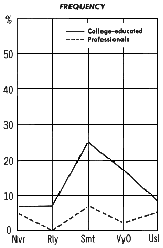 |
| Figure 12-4 EDUCATIONAL LEVEL AND UNNOTICEABILITY OF INTOXICATION |
The users were asked to rate the highest level of intoxication at which others have not noticed they were intoxicated. This was primarily the Strong and Very Strong levels (5%, 15%, 27%, 23%, 5%); thus, users can be experiencing a wide variety of powerful effects without outside observers (friends who were straight at the time) being able to notice any differences in their external behavior. Heavy Total users indicate higher levels for this unnoticeability (Very Strong/Maximum) than Moderate and Light Total users (p < .05, overall), as do Users of Psychedelics (p <.05). More drug experience apparently allows the user to appear normal at very high levels of intoxication.
The converse of unaltered external behavior is "Others (who were straight at the time) have told me that I act very differently when I'm stoned," an infrequent effect (39%, 23%, 21%, 9%, 3%), which may begin to occur at Very Strong levels of intoxication (2%, 5%, 12%, 19%, 11%). As shown in Figure 12-5, acting noticeably different when intoxicated occurs less frequently than no noticeable differences (p <<.0005), and at higher levels (p <.01).
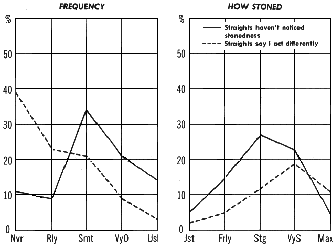 |
| Figure 12-5 EXTERNAL BEHAVIOR INDICATIVE OF BEING INTOXICATED Note.—For guide to interpreting the "How Stoned" graph, see note on Figure 6-1. |
The unawareness of friends that they are intoxicated is often amazing to users; as one informant, a 40-year-old psychologist, put it, "Several times I've gone home stoned, not tremendously so but pretty stoned, and my wife, who knows me incredibly well, hasn't noticed a thing. I stand there seeing all these obvious changes in my experience, and it's just incredible that she doesn't notice!''[1]
Given these general qualities of marijuana intoxication on social groupings, namely, a general quieting effect, let us now examine what changes in social interaction are reported when the user chooses to interact with others.
QUALITY OF SOCIAL INTERACTION
Game Playing
A very characteristic effect of marijuana intoxication is "I find it very hard to play ordinary social games when stoned" (6%, 7%, 21%, 35%, 27%), i.e., various kinds of polite social chit-chat and the like seem hollow and worthless, not worth engaging in. They are "seen through," as later descriptions of effects will indicate. This is reported less frequently by Heavy Total users (p <.0005, overall), suggesting some Heavy Total users have learned to function quite easily in ordinary social settings. The College-educated also experience this difficulty more frequently (p <.05). This effect begins to occur by Moderate levels (13%, 32%, 24% 13%, 5%)
On the other hand, it is common for users to report "I can play elaborate games and get very involved in the games" (14%, 25%, 34%, 17%, 9%), beginning at Moderate to Strong levels (13%, 31%, 30%, 8% 1%). Light Total users have to be more intoxicated for this (p <.05) and Users of Psychedelics less intoxicated (p <.05). The social games played while intoxicated are not always elaborate, however; "when stoned with others, I play 'childish' games; i.e., we interact with each other in ways which are very enjoyable but which people would ordinarily consider childish" is a very common experience (5%, 15%, 51%, 22%, 7%). As one informant put it, "Kids have a lot of fun just doing groovy things like skipping; and if you're stoned with your friends and somebody says 'Wouldn't it be neat to skip down the road?' we may do it and have a ball. We care less that some dumb-ass old authority figure is sitting around and frowning and saying, 'Grownups don't skip!' " Playing childish games may occur in the Moderate to Strong levels and higher (9% 31%, 37%, 15%, 1%).
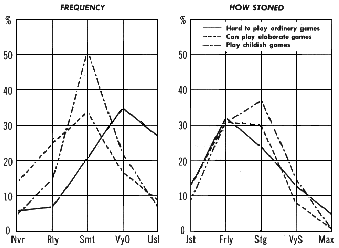 |
| Figure 12-6. SOCIAL GAME PLAYING Note.—For guide to interpreting the "How Stoned" graph, see note on Figure 6-1. |
Figure 12-6 plots the interrelationships of these three aspects of social game playing. Difficulty in playing ordinary games is more frequent than playing childish games (p <.0005), and playing childish games is more frequent than playing elaborate games (p <.01). Playing childish games tends to occur at higher levels than finding it hard to play ordinary social games (p <.05), but there are no other significant differences in level of intoxication.
There are a number of alterations in the perception of social interaction that lie behind the change in overall social interaction, which we shall now consider in decreasing order of frequency.
Insights into Others
A characteristic effect is "I have feelings of deep insights into other people, how they tick, what their games are, when stoned (regardless of whether they check out later)" (7%, 7%, 31%, 34%, 21%). These feelings occur in the Moderate to Strong levels (10%, 35%, 39%, 6%, 2%). A related phenomenon, discussed fully in Chapter 6, is "The face of another person will change even as I watch it, so he keeps changing from one different person to another." Some informants indicate that sometimes this is a purely illusory experience on the part of the perceiver but other times it seems a veridical "illusion" in that it allows insights into the perceived person's character, literally seeing one of the other "persons" within him. Another common, related phenomenon, discussed fully in Chapter 15, is "I learn a great deal about psychological processes, what makes people tick...."
Not only do users characteristically feel as if they have insights into others, they very commonly empathize with them: "I empathize tremendously with others; I feel what they feel; I have a tremendous intuitive understanding of what they're feeling" (7%, 11%, 40%, 25%, 18%). This begins to occur at Moderate to Strong levels of intoxication (12%, 31%, 35%, 10%, 1%). A more extreme form of this, discussed in Chapter 10, is the infrequent feeling of telepathic rapport with others. Indeed, this can reach the point of feeling merged with another person, or being at one with the world, as discussed in Chapter 18.
Profundity
Another very common effect influencing social interaction is "I feel the things I say in conversation when stoned are more profound, more appropriate to the conversation, more interesting" (5%, 13%, 37%, 27%, 15%). This occurs at Moderate to Strong levels (9%, 38%, 31%, 11%, 1%). While most Users of Psychedelics indicate this happens at Fair and Strong levels, Non-users are more variable, indicating Fairly and Very Strongly as main levels (p < .05).
Subtlety and Humor
A related characteristic effect is "I appreciate very subtle humor in what my companions say, and say quite subtly funny things myself," dealt with in Chapter 15. Similarly, the common effect "I giggle a lot when stoned..." is dealt with fully in Chapter 16.
Another related phenomenon, dealt with in Chapter 15, is "Commonplace sayings or conversations seem to have new meanings, more significance."
Group Unity
Our group of marijuana users, then, may be sitting together feeling as if they have increased insight into one another, empathizing more fully with one another, being more childlike and open, and saying more profound things. Thus it is not surprising to find that a very common effect of marijuana intoxication is "When stoned with a group of people, the group takes on a much greater sense of unity, of real social relationship, than when straight; i.e., I feel much more part of a group instead of one person simply in the presence of other people" (7%, 17%, 30%, 25%, 21%). As with the other social effects, this begins to occur at Moderate to Strong levels of intoxication (15%, 35%, 29%, 10%, 0%).[2]
Contact Highs
There is one particularly interesting social effect occurring in groups of users, which further illustrates the importance of psychological variables in affecting the nature of the intoxicated state: "Being with people who are much higher than I am (as from their being on acid or much more stoned on grass) gets me higher even though I don't smoke any more grass." This is a common effect (13%, 13%, 32%, 23%, 15%), which may occur even at the lowest levels of intoxication (23%, 22%, 26%, 5%, 2%).
Related Phenomena
Other relevant phenomena for understanding social interaction are the loss of short-term memory, the feeling that this does not seriously impair the user's ability to carry on an intelligent conversation, and the feeling of having said things that were not actually said (discussed in Chapter 14), as well as various alterations in other cognitive phenomena (discussed in Chapter 15).
NEGATIVE EFFECTS ON SOCIAL INTERACTION
There were four effects studied that seem predominantly negative. The first of these is "I feel isolated from things around me, as if there were some kind of barrier or glass wall between me and the world, muting everything coming in and partially isolating me," a common effect (29%, 21%, 33%, 14%, 3%). The Meditators experience this less often (p <.01, overall). It may occur at the Strong and Very Strong levels (4%, 11%, 22%, 21%, 9%).
Another infrequent effect is "I get somewhat paranoid about the people with me; I am suspicious about what they're doing" (20%, 38%, 31%, 7%, 4%). Non-users of Psychedelics experience it more frequently (p <.01). This also may occur at the Strong and Very Strong levels (9%, 15%, 21%, 24%, 7%). The Meditators tend to experience paranoid feelings at lower levels of intoxication (p <.05, overall).
What may be an even more extreme cutting-off from social relationships is the rare phenomenon, "Other people seem dead, lifeless, as if they were robots, when I'm stoned" (49%, 27%, 18%, 5%, 0%). This effect may begin occurring from the moderately intoxicated level on up in the users who could rate it (3%, 11%, 13%, 14%, 6%). Users of Psychedelics may experience it at lower levels (p <.05).
An infrequent negative effect of the group on the user is "I am very strongly influenced by the social situation set up by my companions, so I will do whatever they are doing, even if it is something I don't want to do or wouldn't do normally" (33%, 38%, 23%, 3%, 0%). This is reported as occurring more frequently by Males (p <.05). Weekly users also have it occur more frequently than Occasional or Daily users (p < .05). In retrospect, this question is hard to interpret, as it does not specify how undesirable the actions are that a group might pressure the user into doing. A highly relevant question, dealt with fully in Chapter 17, is "I lose control of my actions and do antisocial things (actions that harm other people) that I wouldn't normally do." This is one of the rarest phenomena reported, with 77 percent saying Never, 22 percent Rarely, and only one user saying Sometimes. Thus the question on social influence must deal primarily with actions ordinarily unacceptable to the individual, but not necessarily harmful.
ADDITIONAL EFFECTS
Four users mentioned increased feelings of love and compassion toward others: (1) "Increased feelings of tenderness and compassion toward people I'm with, and toward animals, if any present" (Very Often, Strongly); (2) "I become less evaluative of myself and others, more loving" (Usually, Fairly); (3) "I am more concerned with other people's happiness" (Very Often, Fairly); and (4) "If there is some particular person whom I have not cared for, if I get the opportunity to be around him while I'm stoned, I often gain understanding of him and feel very close to him afterwards. The person need not also be stoned" (Very Often, Strongly).
"Feel that many statements made by other people are, more often than not, ambiguous" (Very Often, Strongly).
"When I am with others we tend to share fantasies" (Very Often, Strongly).
"I am more tolerant of other people's beliefs and ideas" (Usually, Fairly).
"I tend to become a member of a group: laugh when they laugh, listen when they listen" (Sometimes, Strongly).
"People seem more violent when I am stoned" (Sometimes, Maximum).
"I enjoy listening to stories about people" (Usually, Strongly).
"I feel much more political" (Very Often, Just).
"A feeling that my friends are different when they're stoned" (Usually, Just).
"Think you would like to turn others on" (Rarely, Maximum).
"Say something and then realize no one heard you—this is frightening, for you're with people and they didn't notice you at all" (Sometimes, Very Strongly).
"I dislike people, especially men who are with me—I see them differently, more clearly, it seems" (Very Often, Fairly).
"An ability to communicate ritual messages" (Usually, Strongly).
"I am aware of multi-level communication; i.e., people are communicating more things than their words express, and often the messages
aren't related, or one is used to communicate another" (Very Often, Strongly).
"A good way to get to know someone more quickly" (Very Often, Fairly).
"I tend to want to be with familiar people who are as stoned as I" (Usually, Maximum).
"Can relate better to my own children" (Very Often, Fairly).
"Strong desire to be alone, bordering on narcissism" (Very Often, Strongly).
"Experience extreme withdrawal" (Sometimes, Just).
"Loneliness has a pleasant rather than an undesirable quality" (Usually, Just).
LEVELS OF INTOXICATION FOR SOCIAL INTERACTION
The effects of marijuana intoxication on social interaction by level of intoxication are summarized in Figure 12-7. The overall ordering of levels is highly significant (p <<< .0005).
| ——Others do not notice I'm stoned—— | ——Others notice I'm stoned—— | ||||||||
| Just | Fairly | Strongly | Very Strongly |
Maximum | |||||
|
|
|||||||||
|
|||||||||
| MERGE, BECOME ONE WITH OTHERS | |||||||||
| PEOPLE'S FACS CHANGE | |||||||||
| OTHERS NOTICE I'M STONED | |||||||||
| Do antisocial things | |||||||||
| FORGET START OF SENTENCE | |||||||||
| AT ONE WITH THE WOPRLD | |||||||||
| THINK I'VE SAID SOMETHNG WHEN I'VE JUST THOUGHT IT |
|||||||||
| FEEL ISOLATED | |||||||||
| CONVERSE INTELLIGENTLY EVEN THOUGH THINGS ARE FORGOTTEN |
|||||||||
| FORGET START OF CONVERSATION | |||||||||
| FEEL PARANOID | |||||||||
| OTHERS STILL DO NOT NOTICE I'M STONED | |||||||||
| TELEPATHY | |||||||||
| People seem dead, like robots | |||||||||
| GIGGLE A LOT | |||||||||
| LEARN A LOT ABOUT WHAT MAKES PEOPLE TICK | |||||||||
| SIGNIFICANCE IN COMMONPLACE CONVERSATIONS | |||||||||
| LESS SOCIABLE | |||||||||
| TALK LESS | |||||||||
| PLAY CHILDISH GAMES | |||||||||
| STRONGLY INFLUENCED BY COMPANIONS | |||||||||
| EMPATHIZE MORE WITH OTHERS | |||||||||
| INSIGHTS INTO OTHERS | |||||||||
| SAY MORE PROFOUND, APPROPRIATE THINGS | |||||||||
| MORE SUBTLE HUMOR | |||||||||
| PLAY ELABORATE GAMES | |||||||||
| MORE GROUP FEELING | |||||||||
| ORDINARY SOCIAL GAMES HARD TO PLAY | |||||||||
| LESS NOISY THAN WHEN STRAIGHT | |||||||||
| TALK MORE | |||||||||
| MORE SOCIABLE | |||||||||
| HIGHER PEOPLE GET ME HIGHER | |||||||||
| LESS NOISY THAN WHEN DRUNK | |||||||||
|
|
|||||||||
| Just | Fairly | Strongly | Very Strongly |
Maximum | |||||
| ——Others do not notice I'm stoned—— | ——Others notice I'm stoned—— | ||||||||
Beginning at Low to Moderate levels, there is a general reduction of loudness and noisiness as the pattern of social interaction begins to change from ordinary interaction to that characteristic of groups of intoxicated users. Ordinary social games become harder to play; users become more sociable and talk more. Thought processes begin to alter so the users feel they have insights into others and interact more subtly, especially with respect to humor. A strong feeling of group solidarity commonly occurs in this Moderate to Strong range of intoxication. Generally, at these low levels, users feel social interaction is greatly enhanced.
As the users begin to enter the Strong ranges and higher, however, inner experience often begins to predominate over social interaction. When social interaction continues, it is usually felt to be very profound. At the highest ranges it includes occasional feelings of telepathic contact and merging with others. Because of the increasing intensity of inner experiences, however, from the Strong level up, many users become less sociable, more wrapped up in themselves. Many of my informants comment that when marijuana is first smoked at a social gathering, there is a lot of interaction, conversing, group discussion, good feeling, but if a lot is smoked, a fair number of people will often begin to withdraw into themselves or become involved in intense dialogues with another user rather than take part in the general group interaction.
Thus low levels of intoxication seem to facilitate and deepen social interaction among users, whereas higher levels may either deepen it further or result in withdrawal from the group.
MODULATING FACTORS
Table 12-1 summarizes the effects of relatively linear background factors on social interaction effects.
Two phenomena were not affected linearly by frequency of use. Weekly users more frequently report being strongly influenced by their companions. They also need to be more intoxicated to believe they've said something when they haven't.
| BACKGROUND FACTORS | EFFECTS | |
|---|---|---|
| More Drug Experience | More frequent: People's faces change Less noisy than when straight Telepathy More subtle humor More intoxicated for: Talk more People haven't noticed I'm stoned Giggle a lot Forget start of conversation |
Less frequent: Think said something when just thought it Feel paranoid Hard to play ordinary social games Less intoxicated for: Quieter than when straight Insights into others People seem like robots Say more profound things Play elaborate games Telepathy |
| Meditation | More frequent: People's faces change Merge with others Feel one with world More intoxicated for: Less sociable |
Less frequent: Talk more Feel isolated Less intoxicated for: Feel paranoid |
| More Educated | Less frequent: Ordinary games hard to play Less intoxicated for: Talk more Merge with others |
|
| Older | More frequent: People haven't noticed I'm stoned |
Less intoxicated for: Talk more Merge with others |
| Males | More frequent: Strongly influenced by companions More intoxicated for: Forget start of sentence |
Less frequent: Giggle a lot |
SUMMARY
In terms of its effects on users' perceptions, marijuana acts as a potentiator of social interaction in the Low to Moderate intoxication levels. Users feel more empathy toward and insights into others, play childish and elaborate games, feel that their conversation is often profound, and commonly experience strong feelings of group unity.
At high levels of intoxication, marijuana may have two different effects on users because of the intensification of inner experiences. The user may become less sociable and withdraw from a group in order to more fully appreciate the inner experiences he is having or, if he continues to interact, may feel that the interaction becomes exceptionally profound, including such things as merging with another person or feeling so aware of another that it seems like telepathic communication.
Negative effects on social interaction are mostly infrequent or rare.
Footnotes
1. This apparent rarity of changes in external behavior should be carefully noted in terms of research methodology; insofar as it is true, behavioristic approaches to this area will waste a lot of time. (back)2. Note, however, that marijuana intoxication does not inevitably create group feelings; if some group members do not fit in or seem "phony," this will kill any feelings of closeness or group coherence. (back)
| < Prev | Next > |
|---|












